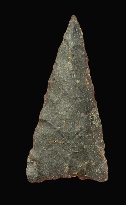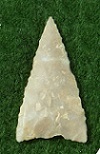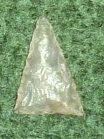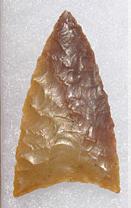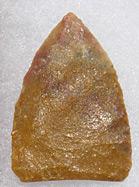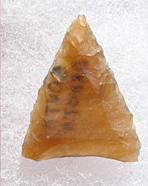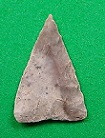Outline is Representative of Size and Shape:

Name Details:
Identified By: Richard "Scotty" MacNeish
Named For:
Date Identified: 1954
Type Site: Stott Mound and Village, Manitoba, Canada
Identified By: Richard "Scotty" MacNeish
Named For:
Date Identified: 1954
Type Site: Stott Mound and Village, Manitoba, Canada
Point Validity:
Valid type
MacNeish was a pioneering anthropologist who was most notable for his excavations and studies at Tamaulipas Mexico. This type has been references in professional publications and has many professional references. This is considered a valid type.
MacNeish was a pioneering anthropologist who was most notable for his excavations and studies at Tamaulipas Mexico. This type has been references in professional publications and has many professional references. This is considered a valid type.
Plains Triangular
Cluster: Plains Triangular Cluster Description of Physical Characteristics and Flaking Pattern:
This is a small (1 to 1.5 inch) thin triangular point with a flattened cross section. The blade is primarily straight, but may vary to slightly excurvate. The base ranges from straight to slightly concave with
sharp basal corners. This point has a random flaking pattern.
Size Measurements:
Length - 10 to 36mm (25mm mean), Width - 10 to 26mm (15.7 mean), Thickness - 2 to 5mm (2.9 mean)
Length - 10 to 36mm (25mm mean), Width - 10 to 26mm (15.7 mean), Thickness - 2 to 5mm (2.9 mean)
Commonly Utilized Material:
Additional Comments:
MacNeish (1954) identified four projectile point types from the Stott Site which included: Plains Triangular, Plains Side Notch, Prairie Side Notch, and Stott Corner Notch.
MacNeish (1954) identified four projectile point types from the Stott Site which included: Plains Triangular, Plains Side Notch, Prairie Side Notch, and Stott Corner Notch.
Distribution: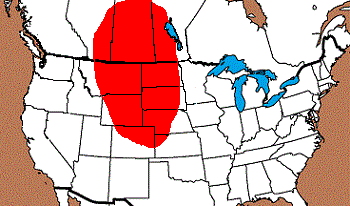
Distribution Comments:
This point is associated with nomadic bison hunters of the plains and prairie region. This point is found from the plains of Saskatchewan and Alberta into the Plains of Montana, North and South Dakota. May be found into the plains region of Colorado, Nebraska and into Kansas. The highest concentrations of these points are found in the southern region of the plains suggesting a Mississippian cultural influence (Drager and Ireland (1986)
This point is associated with nomadic bison hunters of the plains and prairie region. This point is found from the plains of Saskatchewan and Alberta into the Plains of Montana, North and South Dakota. May be found into the plains region of Colorado, Nebraska and into Kansas. The highest concentrations of these points are found in the southern region of the plains suggesting a Mississippian cultural influence (Drager and Ireland (1986)
Age / Periods:
Date: 1,000 - 500 B.P.
Cultural Period: Developmental
Glacial Period: Medieval Warm to Little Ice Age
Culture:
Date: 1,000 - 500 B.P.
Cultural Period: Developmental
Glacial Period: Medieval Warm to Little Ice Age
Culture:
Age Details:
This point is associated with the One Gun Phase of Alberta, Saskatchewan, and into Montana. Radiocarbon dating from bone from the level 6 at the Stott site provided dates of 1,110 +/- 60 B.C.E and 1,040 +/- 50 B.C.E.
This point is associated with the One Gun Phase of Alberta, Saskatchewan, and into Montana. Radiocarbon dating from bone from the level 6 at the Stott site provided dates of 1,110 +/- 60 B.C.E and 1,040 +/- 50 B.C.E.
Other points in this cluster / Related / Associated Points:
Avonlea Carmichael, Avonlea Timber Ridge, Plains Side Notch (and variants), Prairie Side Notch, Stott Corner Notch
Avonlea Carmichael, Avonlea Timber Ridge, Plains Side Notch (and variants), Prairie Side Notch, Stott Corner Notch

